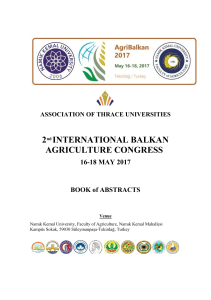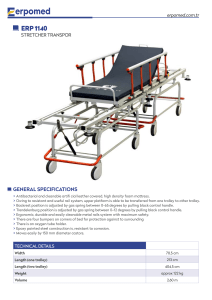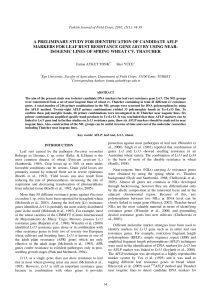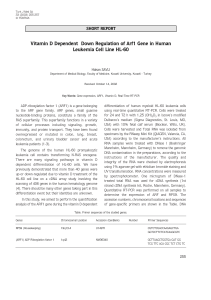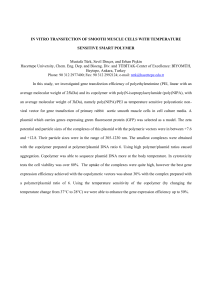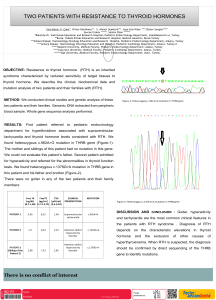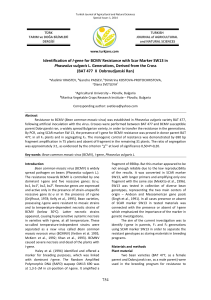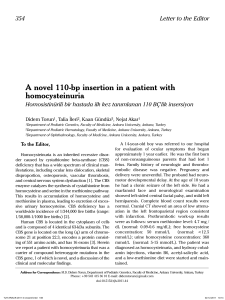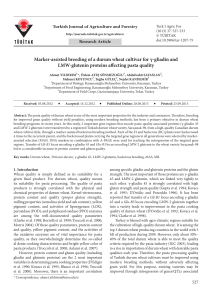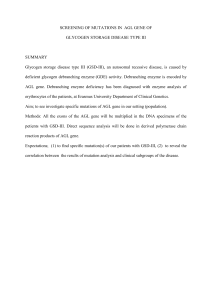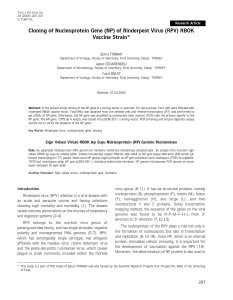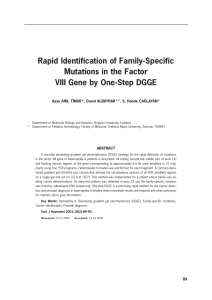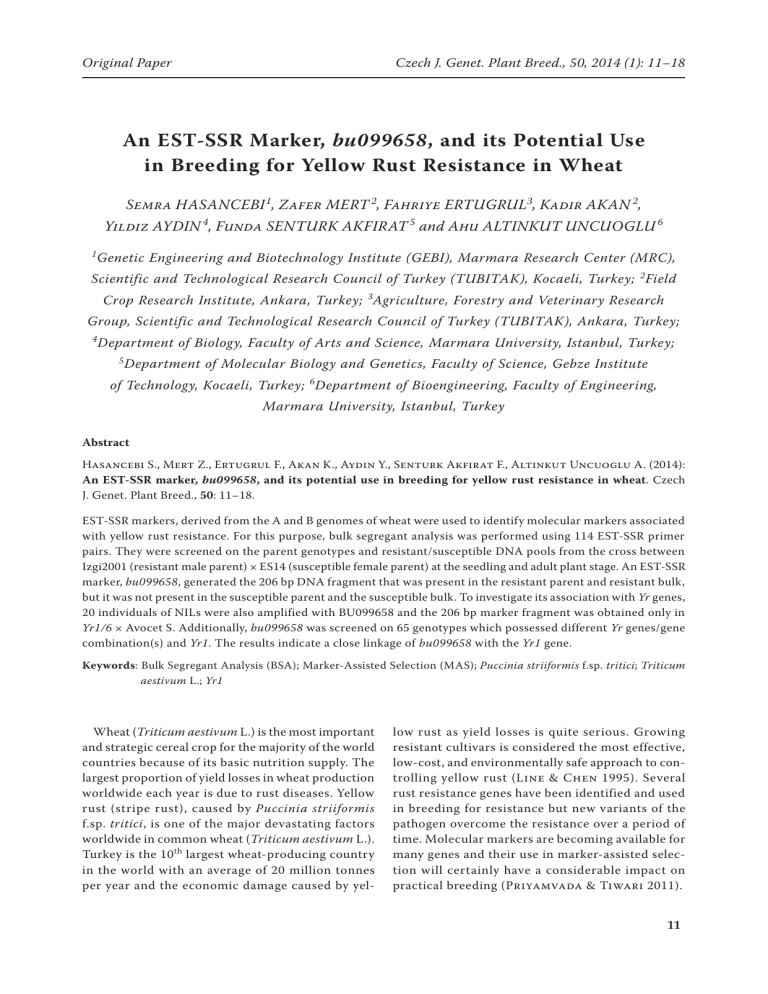
Original Paper
Czech J. Genet. Plant Breed., 50, 2014 (1): 11–18
An EST-SSR Marker, bu099658, and its Potential Use
in Breeding for Yellow Rust Resistance in Wheat
Semra HASANCEBI 1, Zafer MERT 2, Fahriye ERTUGRUL3, Kadir AKAN 2,
Yildiz AYDIN 4, Funda SENTURK AKFIRAT 5 and Ahu ALTINKUT UNCUOGLU 6
1
Genetic Engineering and Biotechnology Institute (GEBI), Marmara Research Center (MRC),
Scientific and Technological Research Council of Turkey (TUBITAK), Kocaeli, Turkey; 2Field
Crop Research Institute, Ankara, Turkey; 3Agriculture, Forestry and Veterinary Research
Group, Scientific and Technological Research Council of Turkey (TUBITAK), Ankara, Turkey;
4
Department of Biology, Faculty of Arts and Science, Marmara University, Istanbul, Turkey;
5
Department of Molecular Biology and Genetics, Faculty of Science, Gebze Institute
of Technology, Kocaeli, Turkey; 6Department of Bioengineering, Faculty of Engineering,
Marmara University, Istanbul, Turkey
Abstract
Hasancebi S., Mert Z., Ertugrul F., Akan K., Aydin Y., Senturk Akfirat F., Altinkut Uncuoglu A. (2014):
An EST-SSR marker, bu099658, and its potential use in breeding for yellow rust resistance in wheat. Czech
J. Genet. Plant Breed., 50: 11–18.
EST-SSR markers, derived from the A and B genomes of wheat were used to identify molecular markers associated
with yellow rust resistance. For this purpose, bulk segregant analysis was performed using 114 EST-SSR primer
pairs. They were screened on the parent genotypes and resistant/susceptible DNA pools from the cross between
Izgi2001 (resistant male parent) × ES14 (susceptible female parent) at the seedling and adult plant stage. An EST-SSR
marker, bu099658, generated the 206 bp DNA fragment that was present in the resistant parent and resistant bulk,
but it was not present in the susceptible parent and the susceptible bulk. To investigate its association with Yr genes,
20 individuals of NILs were also amplified with BU099658 and the 206 bp marker fragment was obtained only in
Yr1/6 × Avocet S. Additionally, bu099658 was screened on 65 genotypes which possessed different Yr genes/gene
combination(s) and Yr1. The results indicate a close linkage of bu099658 with the Yr1 gene.
Keywords: Bulk Segregant Analysis (BSA); Marker-Assisted Selection (MAS); Puccinia striiformis f.sp. tritici; Triticum
aestivum L.; Yr1
Wheat (Triticum aestivum L.) is the most important
and strategic cereal crop for the majority of the world
countries because of its basic nutrition supply. The
largest proportion of yield losses in wheat production
worldwide each year is due to rust diseases. Yellow
rust (stripe rust), caused by Puccinia striiformis
f.sp. tritici, is one of the major devastating factors
worldwide in common wheat (Triticum aestivum L.).
Turkey is the 10 th largest wheat-producing country
in the world with an average of 20 million tonnes
per year and the economic damage caused by yel
low rust as yield losses is quite serious. Growing
resistant cultivars is considered the most effective,
low-cost, and environmentally safe approach to controlling yellow rust (Line & Chen 1995). Several
rust resistance genes have been identified and used
in breeding for resistance but new variants of the
pathogen overcome the resistance over a period of
time. Molecular markers are becoming available for
many genes and their use in marker-assisted selection will certainly have a considerable impact on
practical breeding (Priyamvada & Tiwari 2011).
11
Czech J. Genet. Plant Breed., 50, 2014 (1): 11–18
Molecular markers tightly linked to yellow rust resistance (Yr) genes are very useful for the introduction
of resistance genes into wheat breeding programmes
by Marker-Assisted Selection (MAS) (Todorovska
et al. 2009). Moreover, they are very valuable tools
to select the suitable genotypes for gene pyramiding
to improve the new resistant genotypes containing
two or more Yr genes (Chen 2007). This being the
purpose, many molecular markers, such as Restriction
Fragment Length Polymorphisms (RFLPs) (Helentjaris et al. 1986), Random Amplified Polymorphic
DNAs (RAPDs) (Williams et al. 1990), Amplified
Fragment Length Polymorphisms (AFLPs) (Vos et al.
1995), Resistance Gene Analogs (RGAs) (Kanazin et
al. 1996) and Simple Sequence Repeats (SSRs) (Akkaya et al. 1992) have been widely used in plants. The
successful utility of DNA markers has been shown in
different wheat breeding programmes, namely SCAR
marker (SC-Y15) for Yr17 (Sharp et al. 2001), SSR
markers (Xgwm413 and Xgwm273) for YrH52 (Peng
et al. 2000) and SSR marker (Xgwm498) for Yr26
(Yildirim et al. 2004), for developing resistant wheat
cultivars. Worldwide, yellow rust resistance genes
Yr1–Yr48 and many provisionally designated genes
have been identified in wheat and its relatives (Huang
et al. 2011). However, more markers are needed for
identifying and mapping the genes.
Express Sequence Tags derived from SSRs (ESTSSRs), as genetic markers, have been evaluated in
several studies and these tend to be considerably
less polymorphic than those from genomic DNA for
wheat (Eujayl et al. 2001). However, EST-SSRs have
received a lot of attention because they are derived
from the transcribed region of genes responsible for
the traits of interest. This feature can provide opportunities for gene discovery and enhance the role of
markers by assaying variation in the transcribed and
known gene function (Andersen & Lubberstedt
2003). Recently, an increasing number of ESTs being
deposited in databases for wheat (1.361.764; http://
www.ncbi.nlm.nih.gov/dbEST) and EST-SSRs can
be rapidly developed from the in silico analysis of
these databases at low cost. EST-SSRs are already
available for wheat (www.wheat.pw.usda.gov) and are
transferred to adapted varieties. To date, few ESTSSR markers linked to yellow rust resistance have
been reported (Ercan et al. 2010; Jia et al. 2011).
The objective of the present study was to identify
associated EST-SSR markers for Yr genes that can be
used for MAS in wheat breeding programmes. Here
we report on the identification of bu099658 marker
and its close association with Yr1gene.
12
Original Paper
MATERIAL AND METHODS
Plant material. A cross between the yellow rust
resistant and susceptible Turkish bread wheat cultivar,
Izgi2001 and ES14, respectively, was made in the wheat
breeding programme of the Anatolian Agricultural
Research Institute (AARI). Izgi2001 has Yr1 resistance
gene according to the result of the gene postulation
study conducted by Colin Wellings and Zafer Mert
at the Plant Breeding Institute, Sydney University
(Personal communication). The F2 individuals derived
from Izgi2001 × ES14 were evaluated for yellow rust
resistance at the seedling stage in the greenhouse
and adult stage in the field. Randomly selected 100
F2 individuals were used for an inheritance study of
the marker locus. Additionally, 20 near isogenic lines
(NIL) (Table 1) and a total of 65 wheat genotypes carrying Yr1 or different Yr gene/gene combination(s)
(Table 2) that were supplied from Australia, Syria and
Denmark were used for the identification of linkage
between bu099658 marker locus and Yr1 gene.
Inoculation and disease assessment. Five hundred
F2 individuals derived from the cross were evaluated
for yellow rust resistance both at the seedling stage
in the greenhouse and at the adult stage in the field.
For the inoculations, urediospores of a Pst isolate
Table 1. NIL 06 sets used to study the association of
bu099658 with Yr1 gene
No.
Pedigree
Gene
1
Yr1/6 × Avocet S
Yr1
2
Yr5/6 × Avocet S
Yr5
3
Yr6/6 × Avocet S
Yr6
4
Yr7/6 × Avocet S
Yr7
5
Yr8/6 × Avocet S
Yr8
6
Yr9/6 × Avocet S
Yr9
7
Yr10/6 × Avocet S
Yr10
8
Yr11/3 × Avocet S
Yr11
9
Yr12/3 × Avocet S
Yr12
10
Yr15/6 × Avocet S
Yr15
11
Yr17/6 × Avocet S
Yr17
12
Yr18/3 × Avocet S
Yr18
13
Yr24/3 × Avocet S
Yr24
14
Yr26/3 × Avocet S
Yr26
15
YrSP/6 × Avocet S
YrSP
16
YrSK/3 × Avocet S
Yr27
17
Jupateco R (S)
Yr18+
18
Jupateco S
19
Avocet R
20
Avocet S
YrA
Original Paper
Czech J. Genet. Plant Breed., 50, 2014 (1): 11–18
Table 2. Wheat genotypes screened for validation of the association between bu099658 and the Yr1 gene
No.
Genotype
Yr gene(s)
bu099658 fragment (206 bp)
1
Buster-1
Yr1
+
2
Buster-2
Yr1
3
Galahad
Yr1
+
4
Hobbit
Yr1
–
5
Ritmo
Yr1
+
6
Chinese 166
Yr1
7
Forno
Yr1
8
ISR678.1
Yr1
9
ISR678.39
Yr1
10
ISR 678.40
Yr1
11
ISR.679.19
Yr1
12
ISR 679.20
Yr1
13
Chinese 166
Yr1
+
14
Suwon 92 × Omar
Yr1
–
15
AVS/ 6 × Yr 1
Yr1
+
16
Chinese 166
Yr1
17
Avocet S
Yr1
18
IBIS
Yr1, Yr2
+
19
Tadorna
Yr1, Yr2
–
20
Fenman
Yr1, Yr2
–
21
Stetson
Yr1, Yr9
–
+
+
+
+
Sydney University,
Australia
+
+
+
+
+
+
+
22
Bounty
Yr1, Yr13
23
Galahad
Yr1, Yr2, Yr14
+
24
Maris Ranger
Yr1, Yr3a, Yr4a, Yr6
–
25
Virtue
Yr1, Yr3a, Yr4a, Yr13
+
26
Mardler
Yr1, Yr2, Yr3a, Yr4a, Yr13
–
27
Hustler
Yr1, Yr2, Yr3a, Yr4a, Yr13
–
28
Avocet
Yr32
–
29
Carstens V
Yr32, Yr25 +
–
30
VPM 1
Yr17, +
–
31
Avocet
Yr10
–
32
Moro
Yr10
–
33
Avocet
Yr9
–
34
Sleipner
Yr9, +
–
35
Heines Kolben
Yr6, Yr 2
–
36
Suwon 92 /Omar
So/Yr4
–
37
Hybrid 46
Yr4, +
–
38
Vilmorin23
Yr3, +
–
39
Heines VII
Yr2, Yr25+
–
40
Kalyansona
Yr2, +
–
41
Spaldings Prolific
Sp, Yr25
–
42
Strubes Dickkopf
Sd, Yr25
–
43
Avocet Yr8
Yr8
–
44
Chinese 166
Yr1
45
Compair
Yr8, +
Seed source
ICARDA, Syria
Aarhus University,
Denmark
+
–
13
Czech J. Genet. Plant Breed., 50, 2014 (1): 11–18
Original Paper
Table 2 to be continued
No.
Genotype
Yr gene(s)
bu099658 fragment (206 bp)
46
Avocet Yr7
Yr7
–
47
Lee
Yr7, +
–
48
Avocet Yr6
Yr6
–
49
Heines Peko
Yr6, Yr2, Yr25+
–
50
TP 981
Yr25?
–
51
Ambition
several
–
52
Oakley
several
–
53
Avocet S
U2
–
54
Avocet Yr5
Yr5
–
55
Avocet Yr24
Yr24
–
56
Brigadier
Yr9, Yr17+
–
57
Anja
U1
–
58
Opata
Yr27, Yr18
–
59
Cortez
Yr15
–
60
Cartago
none
–
61
Chinese 166 (winter type)
Yr1
+
62
Moro (winter type)
Yr10
–
63
Yr1/6 × Avocet S
Yr1
+
64
Yr10/6 × Avocet S
Yr10
65
Chinese 166 (winter type)
Yr1
which was virulent for Yr2, Yr6, Yr7, Yr8, Yr9, Yr11,
Yr12, Yr17, Yr18, Yr27, YrA+ and avirulent for Yr1,
Yr5, Yr10, Yr15, Yr24, YrSP, YrCV genes were used.
The most resistant and susceptible F 2 individuals at
the seedling and adult stage were selected for Bulk
Segregant Analysis (BSA) (Michelmore et al. 1991)
after 15–20 days following the inoculation. The
infection type was recorded, using the 0–9 scale of
McNeal et al. (1971) at the seedling stage and the
0-100 scale of the modified Cobb scale (CI) at the
adult stage (Roelfs et al. 1992).
Based on the global virulence mapper (http://
wheatrust.org/international-services/yellow-rust/
global-virulence-mapper/), since 2010 yellow rust
isolates have been avirulent for Yr1 in the Middle
East including Turkey, Azerbaijan and Syria whereas
the effectiveness of Yr1 gene has been decreasing in
Northern Europe (Figure 1).
DNA isolation and EST-SSR screening. Genomic
DNA of leaves was extracted as described by Weining
and Langridge (1991). Aliquots of DNA from 28 resistant and 28 susceptible plants from F2 segregating
population were mixed, respectively, to produce
resistant and susceptible bulks of both growth stages
to be used for BSA. 114 EST-SSR markers derived
from A and B genomes of wheat (Gadaleta et al.
14
Seed source
Aarhus University,
Denmark
+
+
2009) were employed to determine the markers associated with yellow rust resistance.
Fragment analysis by capillary electrophoresis.
A fluorescently labelled BU099658 forward primer
was used for the determination of the polymorphic
DNA fragment. PCR mixtures were prepared according to the GenomeLab GeXP System manufacturer’s
(Beckman Coulter, Brea, USA) instructions. The
electrophoretic separation was performed using the
GenomeLab GeXP Genetic Analysis System and the
data was analysed by a fragment analysis module
of the system. Each experiment was replicated at
least three times to verify the reproducibility of the
marker analysis.
RESULTS AND DISCUSSION
Infection type and CI values of selected resistant
F2 individuals were between 0 and 1 at the seedling stage
and about 20 at the adult plant stage, while susceptible
F2 individuals were 8–9 at the seedling stage and 60–90
at the adult plant stage. The isolates used in this study
are avirulent for Yr1 based on the gene postulation
study (supplementary info). Based on disease scoring
data, the 28 most resistant and 28 most susceptible
F2 seedlings were taken into consideration for BSA.
Original Paper
Czech J. Genet. Plant Breed., 50, 2014 (1): 11–18
Virulent
Among the 114 EST-SSR markers (Table 3) employed
in this study, 99 of them (87%) revealed a monomorphic
band profile between the two parents. The remaining 15
markers (13%) amplified polymorphic DNA fragments
except for bu099658, while others did not produce such
polymorphic band profiles between bulks. BU099658
amplified a 206 bp DNA fragment that was present
in the resistant parent and in the resistant bulks, but
not in the susceptible ones both for seedling and adult
plant stages (Figure 2). A linkage between the bu099658
locus mapped on chromosome group 2A and 2B and
yellow rust resistance was confirmed in 28 resistant F2
individuals at both growth stages. The 206 bp fragment,
Avirulent
Figure 1. Map of Yr1 virulence
in Northern Europe and Middle East during 2010–2012;
data provided by: Institut
National de la Recherche
Agronomique (France), Julius Kühn-Institut, Federal
Research Centre for Cultivated Plants (Germany and
Austria), National Institute
of Agricultural Botany (United Kingdom) and Aarhus
University (Denmark and
Sweden); N – No. of virulent
Pst isolates/No. of analysed
Pst isolates in a country
indicated by an arrow, was present in all 28 individuals
in the resistant bulks, but not in the susceptible ones
at both stages (Figure 2).
A new generation fluorescence-based capillary electrophoresis system was also used for the verification
of the sizes of fragments generated by the BU099658.
Figure 3 shows the fragment profile of the Izgi2001 with
six peaks labelled as 168.20; 206.20; 222.43; 225.61;
227.70 bp and 230.75 bp, and also shows the fragment
profile of the ES14 with five peaks 168.80; 222.54; 225.58;
227.57 bp and 230.84 bp. The 206 bp fragment was
amplified in the resistant parent and resistant bulks
at both growth stages but not in the susceptible ones.
Table 3. Screened EST-SSR markers (polymorphic markers used in this study are shown in bold); primer sequences are
reported on the website http://wheat.pw.usda.gov
CA681959
BJ262177
BQ170801
TC84481
TC88833
TC70788a
CA716967
BJ239878
BQ805704
TC85303
TC70788b
CA594434
BJ306922
BQ246417
TC91851
TC74823
TC65966
TC69046
TC91851
TC87195a
TC71236
TC87195b
TC77302
TC84464
TC67645
CA668788
TC85294
TC88560
BJ213673
BE419757
TC85125a
TC77994
CA724675
BJ267382
BE427655
TC95235
TC80528
TC85125b
TC77993
CA594434
BJ318987
BF483631
TC84551
TC89014
TC92445
TC101037
CA681959
BJ227727
TC91645
TC87011
TC86533
BU099658
TC70722
CA662535
BJ253815
NP234852a
TC69046
TC85050
TC69177
CA741577
CA677684
BJ237020a
NP234852b
TC85294
TC77481
TC95791
CA703897
CA623872
BJ237020b
AL825137ab
TC80528
TC84481a
CA594434
CA499601
BJ262177
AL825137b
TC81688b
TC80528
TC84481b
CA597228
CA499463a
BJ261821
TC88378
TC69937
TC85035a
CA679329
CA499463b
BJ236800a
TC90641
TC72953
TC85035b
CA651264
CA694714
BJ236800b
TC90640
TC86610
TC85037a
CA677684
CA663888
BJ213673
TC82001
TC89014
TC85037b
CA658758
CA707573
BQ607256
TC81096
TC82742
TC67416
CA695634
CA668775
BQ838884
TC81688a
15
Czech J. Genet. Plant Breed., 50, 2014 (1): 11–18
Original Paper
NILs were screened by the BU099658 primer pair
to validate associations between the marker locus and
Yr gene. As expected, while only Yr1 including Yr1/6 ×
Avocet S produced a 206 bp marker fragment, others did
not. In addition, 21 genotypes carrying Yr1, 10 genotypes
carrying Yr1 in combination with other Yr gene/genes
and 34 genotypes lacking Yr1 (Table 2) were used for
validation. Genotypes carrying the Yr1 gene including
Chinese 166, as the reference sources for this gene,
were used by Bansal et al. (2009) for validation of
the linkage between Yr1 and stm673acag. The marker
fragment (206 bp) belonging to the bu099658 locus was
amplified in all of the 19 genotypes carrying Yr1 and
another 4 individuals carrying Yr1 gene in combination with other Yr gene/genes, which demonstrated the
same pattern with the resistant parent, Izgi2001. The
remaining genotypes gave exactly the same amplification profile with the susceptible parent, ES14, and did
not amplify the marker fragment (Table 2).
In order to determine the inheritance of the
bu099658 locus, PCR amplification was performed in
100 F2 individuals of Izgi2001 × ES14. In this analysis,
71 plants produced the polymorphic 206 bp marker
fragment, while it was not produced by 29 plants,
which fits a 3:1 ratio (χ 2 test, P = 0.25–0.50). This
chi-squared analysis supported monogenic inheritance of Izgi2001 resistance to yellow rust.
In this study, we reported on the detection of the
bu099658 EST-SSR marker, linked to the seedling and
adult plant resistance to yellow rust. An F2 population
from a cross between Izgi2001 and ES14 was visually
assessed for seedling infection type in the greenhouse
and adult plant infection in the field. In repeated amplifications, the presence of the 206 bp EST-SSR marker
may significantly enhance the selection of wheat genotypes for yellow rust resistance. Screening of NILs and
65 wheat genotypes which have Yr1 or other Yr genes by
bu099658 showed that only Yr1/6 × Avocet S from NILs
and all of the 19 genotypes carrying Yr1 from validation
sets amplified the 206 bp EST-SSR marker fragment.
These results supported our suggestion that this marker
fragment is closely linked to the Yr1 gene. Bariana and
McIntosh (1993) predicted a distal location of Yr1 on
chromosome 2AL based on recombination studies of
rust resistance loci. Bansal et al. (2009) reported the
genetic relationship between the genes Yr1 and Sr48
on chromosome 2AL. The close linkage was identified
between Yr1 and the PCR-based molecular marker
stm673acag. Genotyping with stm673acag amplified
a 120-bp fragment in 8 of 9 wheat genotypes carrying
Yr1, also used in this study for validation. However,
the line ISR679.20 amplified a 124-bp allele present in
Australian cultivars lacking Yr1. This marker failed to
differentiate Avocet S × 6⁄Chinese 166 (Yr1) and Avocet
S by amplifying a 120-bp product in both genotypes.
Thus, the line ISR679.20 and Avocet S were genotyped
as false negative and false positive by the author. In
contrast, BU099658 did not produce any false positive
or false negative results for Yr1 in our work. Therefore, we estimated that this marker could be useful for
(a)
(b)
Figure 2. Bulk segregant analysis of the bu099658 marker in resistant and susceptible F2 individuals at both stages:
resistant F2 individuals at the seedling stage (a), susceptible F2 individuals at the adult stage (b); SRB – seedling resistant
bulk, SSB – seedling susceptible bulk, ARB – adult resistant bulk, ASB – adult susceptible bulk, C – negative control,
1–28: F2 individuals in the resistant/susceptible bulk; black and white arrows show the 206 bp bu099658 marker fragment
16
Original Paper
Czech J. Genet. Plant Breed., 50, 2014 (1): 11–18
RP (Izgi2001)
40 000
ARB
SRB
10 000
25 000
222.61
222.43
20 000
Dye signal
30 000
8 000
206.06
206.20
222.31
15 000
6 000
20 000
230.75
226.40
230.41
5 000
227.70
225.61
168.20
0
0
150
168.42
0
200
SP (ES14)
35 000
2 000
224.43
168.29
0
200
230.92
4 000
10 000
10 000
250
ASB
227.57
0
150
200
250
SSB
40 000
227.57
20 000
15 000
225.54
5 000
10 000
230.84
20 000
225.58
10 000
224.58
168.30
168.72
168.29
222.54
0
0
0
150
226.62
30 000
30 000
25 000
Dye signal
206.34
200
250
0
0
150
Size (nt)
200
Size (nt)
250
0
50
100
150
200
250
Size (nt)
Figure 3. Fluorescence-based capillary electrophoresis; the bu099658 marker in parents and F2 resistant and susceptible
bulks at both stages; red arrows and circles show the 206 bp marker fragment; M – DNA size marker (50 bp), ARB – resistance bulk at the adult stage, ASB – susceptible bulk at the adult stage, SP – susceptible parent (ES14), RP – resistance
parent (Izgi01), SRB – resistance bulk at the seedling stage, SSB – susceptible bulk at the seedling stage
MAS in breeding programmes aimed at the large scale
for the screening of segregating populations for Yr1.
Bansal et al. (2009) mapped markers Xgwm311 and
Xgwm382 with a 5 and 5.6 cM proximal distance to Yr1
in an Arina/Forno RIL population. Previously, we also
detected the presence of Xgwm382 (Akfirat-Senturk
et al. 2010) and Xgwm311 (Akfirat-Senturk et al.
2013) markers in resistant germplasm of the Izgi2001 ×
ES14 cross. According to the genetic map presented
in Somers et al. (2004), the marker Xgwm311 was the
most distal marker on chromosome 2AL, followed by
the marker Xgwm382. Identification of a close or loose
genetic association between Yr1 and bu099658 will be
confirmed by linkage mapping in the Izgi2001 × ES14
population in our forthcoming studies.
Acknowledgements. This study was supported by the TUBITAK, KAMAG 105G075 Project. We are thankful to Prof. Dr. C.
Wellings, Dr. H. Bariana and Dr. U. Bansal from the Plant
Breeding Institute of Sydney University for their comments and
kind help for supplying genotypes carrying Yr1. We are also indebted to Dr. N. Bolat for providing the plant material, K. Bulut
and R. Buyukkeskin for their experimental assistance.
References
Akfirat-Senturk F., Aydin Y., Ertugrul F., Hasancebi S.,
Budak H., Akan K., Mert Z., Bolat N., Uncuoglu
Altinkut A. (2010): A microsatelite marker for yellow
rust resistance in wheat. Cereal Research Communications,
38: 203–210.
Akfirat-Senturk F., Ertugrul F., Hasancebi S., Aydin Y.,
Akan K., Mert Z., Cakir M., Uncuoglu Altinkut A.
(2013): Chromosomal location of genomic SSR markers associated with yellow rust resistance in Turkish bread wheat
(Triticum aestivum L.). Journal of Genetics, 92: 233–240.
17
Czech J. Genet. Plant Breed., 50, 2014 (1): 11–18
Original Paper
Akkaya M.S., Bhagwat A.A., Cregan P.B. (1992): Length
polymorphisms of simple sequence repeat DNA in soybean. Genetics, 132: 1131–1139.
andersen J.R., Lubberstedt T. (2003): Functional markers
in plants. Trends in Plant Science, 8: 554–560.
Bansal U.K., Haydenb M.J., Kellerc B., Wellingsa
C.R., Parka R.F., Bariana H.S. (2009): Relationship
between wheat rust resistance genes Yr1 and Sr48 and a
microsatellite marker. Plant Pathology, 58: 1039–1043.
Bariana H.S., Mcintosh R.A. (1993): Cytogenetic studies
in wheat XV. Location of rust resistance genes in VPM1
and their genetic linkage with other resistance genes in
chromosome 2A. Genome, 36: 476–82.
Chen M.X. (2007): Challenges and solutions for stripe
rust control in the United States. Australian Journal of
Agricultural Research, 58: 648–655.
Ercan S., Ertugrul F., Aydin Y., Akfirat S.F., Hasancebi S., Akan K., Mert Z., Bolat N., Yorgancilar O.,
Uncuoglu A.A. (2010): An EST-SSR marker linked with
yellow rust resistance in wheat (Triticum aestivum L.).
Biologia Plantarum, 4: 691–696.
Eujayl I., Sorrells M., Baum M., Wolters P., Powell
W. (2001): Assessment of genotypic variation among
cultivated durum wheat based on EST-SSRs and genomic
SSRs. Euphytica, 119: 39–43.
Gadaleta A., Giancaspro A., Giove S.L., Zacheo S.,
Mangini G., Simeone R., Signorile A., Blanco A.
(2009): Genetic and physical mapping of new EST-derived
SSRs on the A and B genome chromosomes of wheat.
Theoretical and Applied Genetics, 118: 1015–1025.
Helentjaris T., Slocum M., Wright S., Schaefer A.,
Nienhuis J. (1986): Construction of linkage maps in maize
and tomato using restriction fragment length polymorphisms. Theoretical and Applied Genetics, 72: 761–769.
Huang L., Zhang L.Q., Liu B.L., Yan Z.H., Zhang B.,
Zhang H.G., Zheng Y.L., Liu D.C. (2011): Molecular tagging of a stripe rust resistance gene in Aegilops tauschii.
Euphytica, 179: 313–318.
Jia J., Li G.R., Liu C., Lei M.P., Yang Z.J. (2011): Characterization of wheat yellow rust resistance Gene Yr17
Using EST-SSR and rice syntenic region. Cereal Research
Communications, 39: 88–99.
Kanazin V., Marek L.F., Shoemaker R.C. (1996). Resistance gene analogs are conserved and clustered in soybean.
Proceedings of the National Academy of Sciences of the
United States of America, 93: 11746–11750.
Line R.F., Chen X.M. (1995): Successes in breeding for
and managing durable resistance to wheat rusts. Plant
Disease, 79: 1254–1255.
McNeal F.M., Conzak C.F., Smith E.P., Tade W.S., Russell T.S. (1971): A uniform system for recording and
processing. Cereal Research Data – USDA, Washington.
Michelmore R.W., Paran I., Kesseli R. V. (1991): Identification of markers linked to disease-resistance genes
by bulked segregant analysis: a rapid method to detect
markers in specific genomic regions by using segregating
populations. Proceedings of the National Academy of
Sciences of the United States of America, 88: 9828–9832.
Peng J.H., Fahima T., Röder M S., Li Y.C., Grama A., Nevo
E. (2000): Microsatellite high-density mapping of the stripe
rust resistance gene YrH52 region on chromosome 1B and
evaluation of its marker-assisted selection in the F2 generation in wild emmer wheat. New Phytologist, 146: 141–154.
Priyamvada Saharan M.S., Tiwari R. (2011): Durable
resistance in wheat. International Journal of Genetics and
Molecular Biology, 3: 108–114.
Roelfs A.P., Singh R., Saari E.E. (1992): Rust Diseases of
Wheat: Concepts and Methods of Diseases Management.
DF-CIMMYT, Mexico.
Sharp P.J., Johnston S., Brown G., Mcintosh R.A., Pallotta M., Carter M., Bariana H.S., Khartkar S.,
Lagudah E.S., Singh R.P., Khairallah M., Potter R.,
Jones M.G. (2001): Validation of molecular markers for
wheat breeding. Crop and Pasture Science, 52: 1357–1366.
Somers D.J., Isaac P., Edwards K. (2004): A high density microsatellite consensus map for bread wheat (Triticum aestivum L.). Theoretical and Applied Genetics, 109: 1105–1114.
Todorovska E., Christov N., Slavov S., Christova P.,
Vassilev D. (2009): Biotic stress resistance in wheat –
breeding and genomic selection implications. Biotechnology and Biotechnological Equipment, 23: 1417–1426.
Vos P., Hogers R., Bleeker M., Reijans M., Van De Lee T.,
Hornes M., Frijters A., Pot J., Peleman J., Kuiper
M., Zabeau M. (1995): AFLP: a new technique for DNA
fingerprinting. Nucleic Acids Research, 11: 4407–4414.
Weining S., Langridge P. (1991): Identification and mapping of polymorphism in cereals based on the polymerase
chain reaction. Theoretical Applied Genetics, 82: 209–216.
Williams J.G.K., Kubelik A.R., Livak K.J., Rafalski J.A.,
Tingey S.V. (1990): DNA polymorphisms amplified by
arbitrary primers are useful as genetic markers. Nucleic
Acids Research, 18: 6531–6535.
Yildirim A., Karadag Y., Sakin M.A., Gokmen S., Kandemir N., Akkaya M.S., Yildirim F. (2004): Transfer of
stripe rust resistance gene Yr26 to Turkish wheats using
microsatellite markers. Cereal Research Communications, 32: 25–30.
Received for publication May 31, 2013
Accepted after corrections December 4, 2013
Corresponding author:
Assoc. Prof. Ahu Altinkut Uncuoglu, Marmara University, Faculty of Engineering, Department of Bioengineering,
Goztepe Campus, 34722 Istanbul, Turkey; e-mail: ahu.uncuoglu@marmara.edu.tr
18

